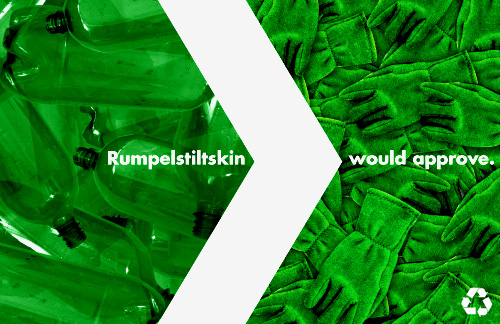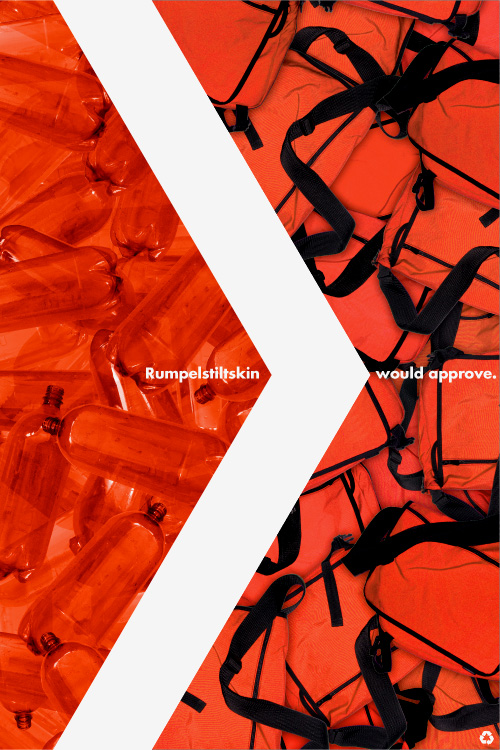What Do You Call Someone Who…
February 15, 2010 at 9:31 pm · Filed under Advertising / Campaigns, Copy / Writing, Photography / Film, Print / Editorial, Signage / Display

Rumpelstiltskin would approve. recycling awareness campaign postcard, showing PET bottles going into winter gloves; 7 x 5 in. / 2002
“Designer” is an ethereal thing to call oneself, fraught with misconception and expectation. When I describe myself as such, people I meet invariably respond with the exact same, ever-more-annoying, eight-word phrase: “Oh—that’s, like, with computers and stuff, right?” (I can only imagine that there was some 20/20 John Stossel exposé about the suspicious rise of the machines in the late ’80s—replete with footage of designers large in glasses and shoulder-padding huddled around a tiny Macintosh, working to draw pastel and black magic from it—that permanently ingrained this concept in society at large.) Moreover, most people assume I use my computers and stuff for advertising, where I spin everyday goods into objects of mythical lust…
The truth is, they’re right. Ironically, most of the people who assume my job is about computers rely on them far more than I in order to successfully carry out a project (seriously, who doesn’t use computers these days?), but computers are used as tools to build design files (the ideas, however, still have to come out of a human head). And the line between advertising and design is blurry and often crossed. In setting up this project for our Visualizations class in the Visual Communication Design program at the University of Washington, our professor relayed a quip from a friend of his that went something like this: “Design is a lame idea that just looks good. Advertising is a great idea that looks like crap.” In addition to being pretty humorous, this is also about as true as it is frightening. The last thing I want to do is make something look good for no reason.
Our assignment, then, was to choose from one of several public interests and devise a suitably “big idea” that would powerfully illuminate the subject from a new perspective. This idea would form the backbone of a campaign—typically the domain of the “Ad Man” (sorry, ladies; no clever name for you). To keep us thinking big (and to be sure we didn’t delve into any typical designer-y things involving complex or abstract typography, or ironic plays on the medium), we were limited to just three words for the entire campaign, and they had to carry the idea across a vast range of formats. And, we were supposed to make it look good, too.

Rumpelstiltskin would approve. recycling awareness campaign poster, showing PET bottles going into canvas messenger bags; 24 x 36 in. / 2002
My topic was recycling, and my big idea was based on the notion that truth is stranger than fable. Recycling realizes far more than most people believe it can. Every year, hundreds of millions of pounds of PET plastic (e.g., soda pop bottles) are recycled, but where do they go? Well, aside from new soda bottles, many industries have used this material as an effective alternative to more expensive, less eco-friendly, and/or simply inferior traditional resources. In fact, recycled PET is used every day to create new products such as lumber, fencing, furniture, and auto parts.

Rumpelstiltskin would approve. recycling awareness campaign bus sign, showing PET bottles going into fleece vests; approx. 20 x 4 ft. / 2002
Perhaps the most successful example of this visionary recycling is the work of the clothing industry. Though hard to believe, soda bottles and other such containers can be broken down into pellets, which are then spun into very high quality yarn. This fiber can be used exclusively or blended with natural fibers like cotton to create just about any garment one could imagine.
After an initial struggle with over-complex diagrammatic visual language to show this fantastic process, I ended up settling on a simple arrow form symbolizing the forward progress inherent in this transformation and punctuating the campaign line. I shot photographs of the materials with an antique 35mm camera, then used computers and stuff to scan, colorize and compose the pieces in the different layouts.
Rumpelstiltskin was invoked to make people consider the amazing—perhaps even mythical—power of modern recycling. We may not be able to spin straw into gold, but spinning pop bottles into polar fleece ain’t bad.
